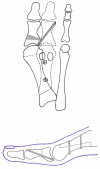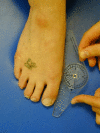Combined rotation scarf and Akin osteotomies for hallux valgus: a patient focussed 9 year follow up of 50 patients
- PMID: 20156363
- PMCID: PMC2833148
- DOI: 10.1186/1757-1146-3-2
Combined rotation scarf and Akin osteotomies for hallux valgus: a patient focussed 9 year follow up of 50 patients
Abstract
Background: The Cochrane review of hallux valgus surgery has disputed the scientific validity of hallux valgus research. Scoring systems and surrogate measures such as x-ray angles are commonly reported at just one year post operatively but these are of dubious relevance to the patient. In this study we extended the follow up to a minimum of 8 years and sought to address patient specific concerns with hallux valgus surgery. The long term follow up also allowed a comprehensive review of the complications associated with the combined rotation scarf and Akin osteotomies.
Methods: Between 1996 and 1999, 101 patients underwent rotation scarf and Akin osteotomies for the treatment of hallux valgus. All patients were contacted and asked to participate in this study. 50 female participants were available allowing review of 73 procedures. The average follow up was over 9 years and the average age at the time of surgery was 57. The participants were physically examined and interviewed.
Results: Post-operatively, in 86% of the participants there were no footwear restrictions. Stiffness of the first metatarsophalangeal joint was reported in 8% (6 feet); 10% were unhappy with the cosmetic appearance of their feet, 3 feet had hallux varus, and 2 feet had recurrent hallux valgus. There were no foot-related activity restrictions in 92% of the group. Metatarsalgia occurred in 4% (3 feet). 96% were better than before surgery and 88% were completely satisfied with their post-operative result. Hallux varus was the greatest single cause of dissatisfaction. The most common adverse event in the study was internal fixation irritation. Hallux valgus surgery is not without risk and these findings could be useful in the informed consent process.
Conclusions: When combined the rotation scarf and Akin osteotomies are an effective treatment for hallux valgus that achieves good long-term correction with a low incidence of recurrence, footwear restriction or metatarsalgia. The nature of the osteotomies allows early return to normal shoes and activity without the need for postoperative immobilisation in a plaster cast.
Figures








References
-
- Ferrari J, Higgins JP, Prior TD. Interventions for treating hallux valgus (abductovalgus) and bunions (Cochrane Review) Cochrane Database of Systematic Reviews. 2004. p. CD000964. - PubMed
-
- Kilmartin TE. Critical Review: The surgical management of Hallux valgus. Br J Podiatry. 2006;9:4–25.
-
- O'Kane C, Kilmartin TE. The rotation Scarf and Akin osteotomy for the correction of severe hallux valgus. Foot. 2002;12:203–212. doi: 10.1016/S0958259202000329. - DOI
LinkOut - more resources
Full Text Sources
Other Literature Sources
Miscellaneous

